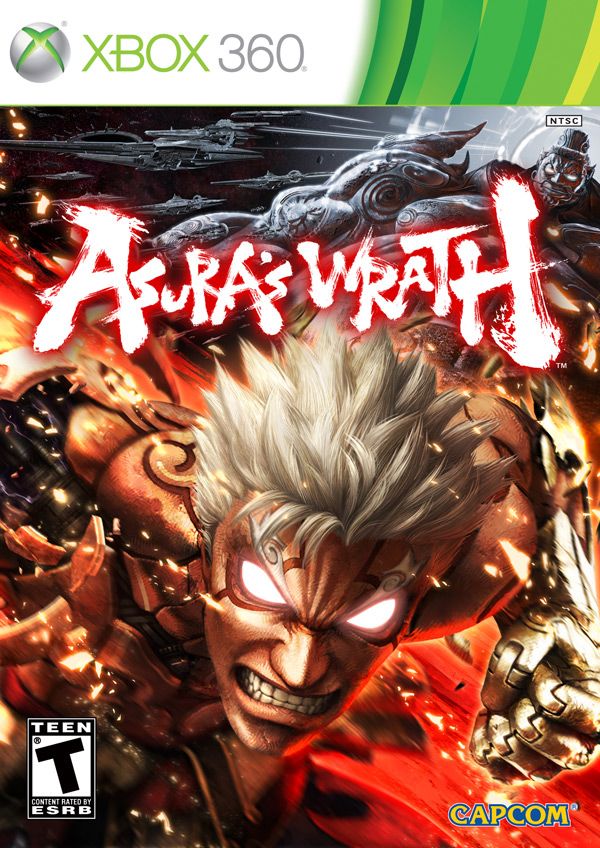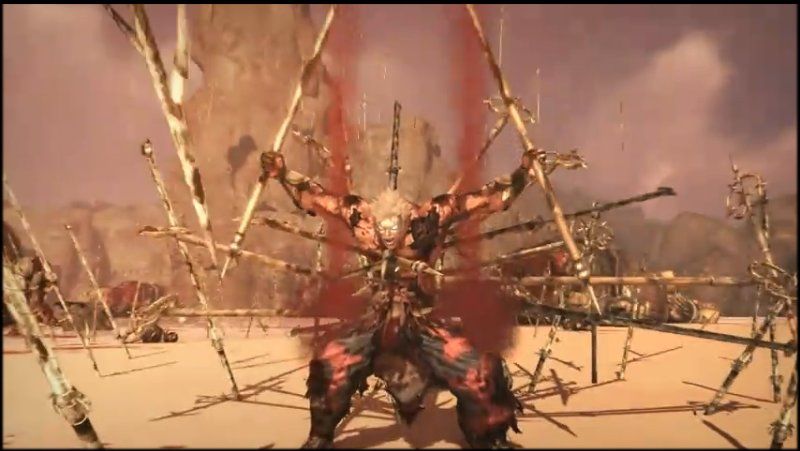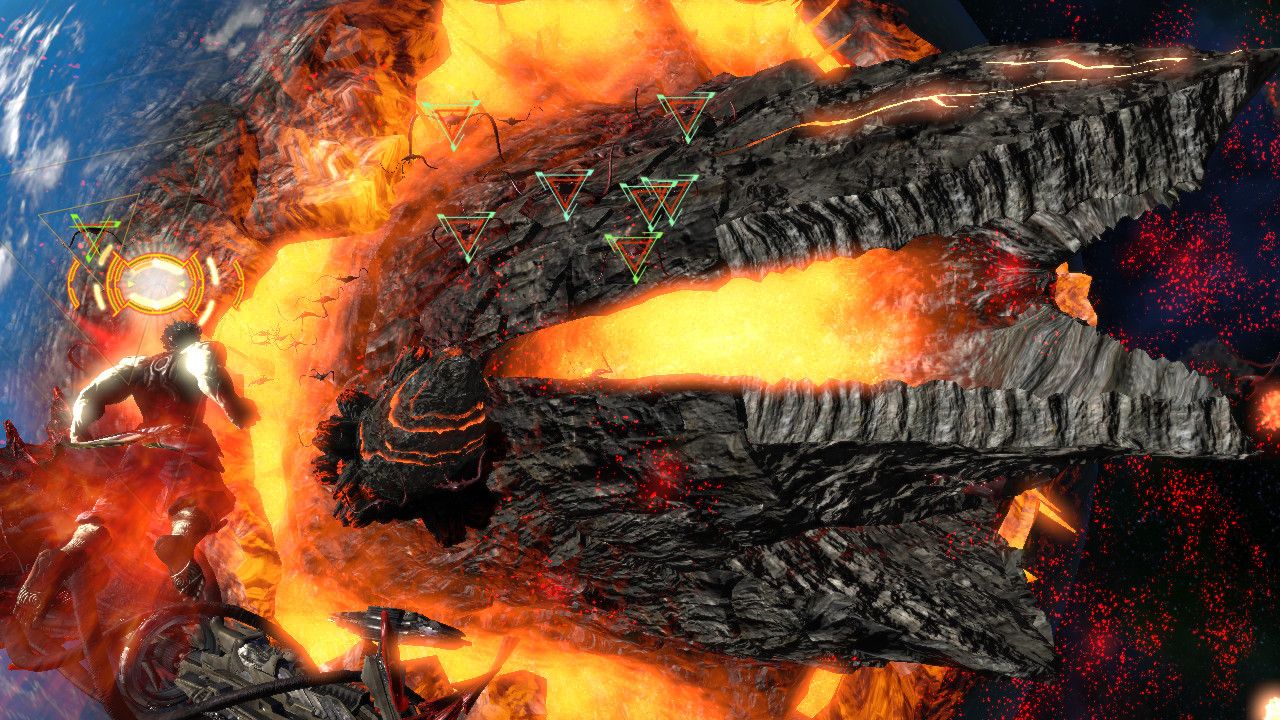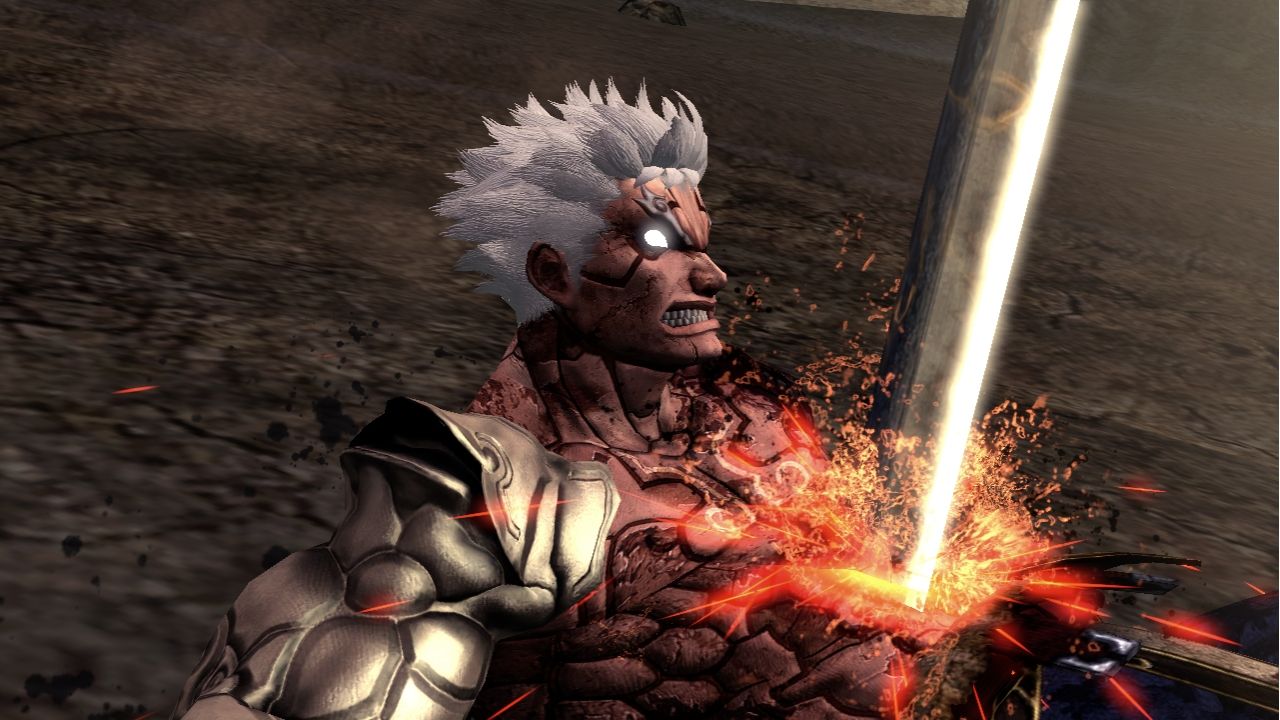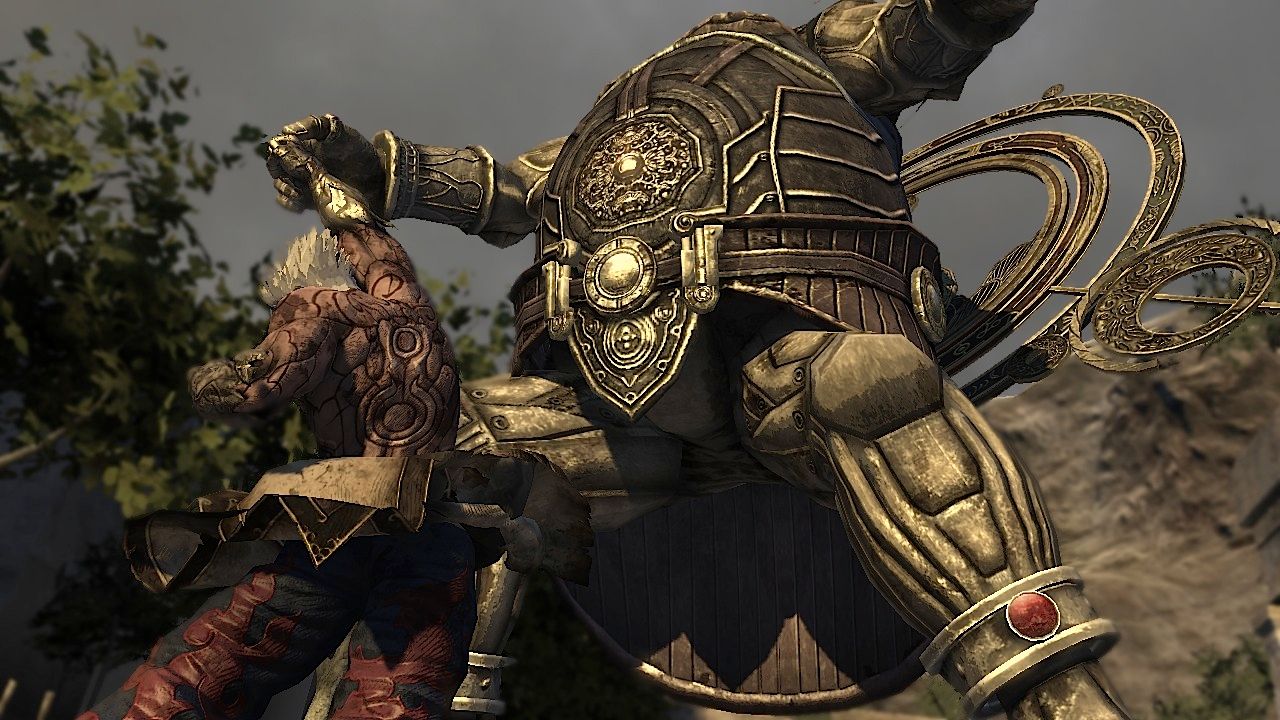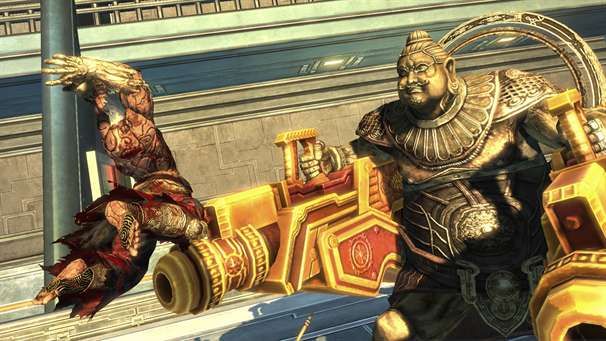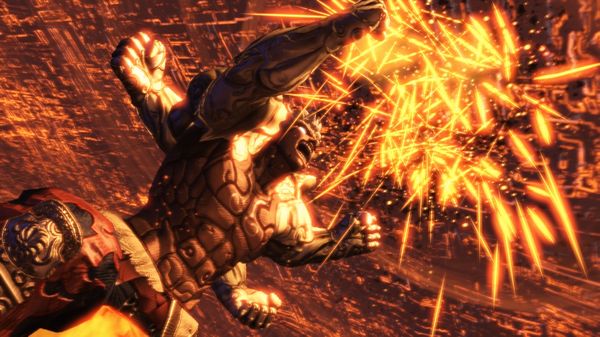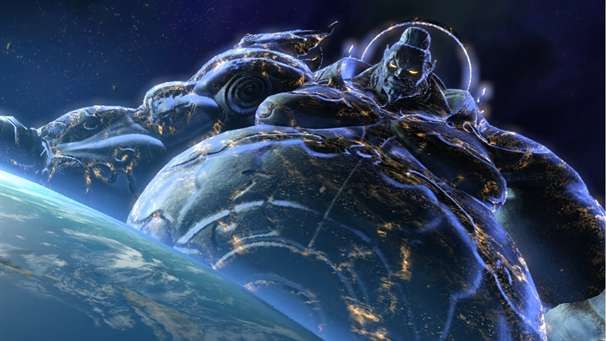Asura is pissed. And understandably so. After coming home from a major victory, the demigod is framed for the murder of his emperor while his wife is assassinated and daughter abducted. It’s understandable, then, that the majority of Asura’s Wrath is spent kicking and punching your way through hordes of enemies as the titular character rages at anyone and everything that dares come close.
The game’s backdrop is the classic struggle of a disgraced god who yearns to reclaim his place in the heavens. All the while, demons from within the planet known as the Gohma wreak havoc in a war with the demigods to control the souls of its people. Much of this story is told through interactive cut scenes, which outnumber sequences in which you have full control of Asura or the game’s other playable character.
Before he was banished from the paradise of Shinkoku, Asura served as one of the eight Guardian Generals. Once disgraced, he wakes up in Naraka, a take on Eastern portrayals of hell. Once he climbs his way to the mortal world, 12,000 years have passed and his comrades are now the Seven Deities, who use their influence over humans to collect their souls and use them in less-than-scrupulous ways.
When you’re actually playing, Asura’s Wrath has two basic scenarios: You’re either punching or shooting. The combat sections are your basic button-mashing fare. Tap the attack button with a few heavy and jump attacks sprinkled in and your fights are as good as won. A few boss encounters will require that you dodge or utilize the quick-recovery feature, but it’s not often that overlooking these tenets of the game will cause you penalty.
Shooting sections take a cue from rail shooters. You control your character as he forever moves forward, decimating anything that gets in his way. Of course, the game wouldn’t live up to the kickpunching standard it sets in the opening cinematic if Asura’s projectiles weren’t plasma-charged fists. While these segments offer a nice break from the monotony of beating punch fodder to a pulp, they’re a bit lacking in most respects.
For starters, there’s no way to set what you’re aiming at. Simply having a character look at a battleship causes him to lock on. At that point it’s up to you to unleash a locked attack in order to move on to another target. The points Asura and the other playable character choose to focus on also seem completely arbitrary. There never seems to be a rhyme or reason for the parts of an enemy you’re shooting down, which makes fights less meaningful than they could be otherwise.
Regardless of whether you’re punching or shooting, combat segments follow a basic formula: Fight, burst, repeat. The burst gauge at the top of the screen gradually fills up the more damage you do to enemies. The harder the hit, the quicker the gauge loads. Once the burst gauge is full, pull the right trigger and a quicktime event begins to finish off whatever episode you’re on.
You’d better get used to quicktime events, because that’s where you’ll spend the majority of your Asura’s Wrath experience. Segments of the game where I spent a 15-20 minutes sitting in front of my TV were only five or six long according to the stat screen that capped off those episodes. If there’s one redeeming quality to these cutscenes, it’s that the contextual button prompts often follow what you see onscreen. Need to dodge left? You’ll probably be prompted to move both sticks in that direction.
Not every button press needs to be done in a timely manner in order to move the action forward. At one point early in the game I decided to get a few things done as Asura crushed a starship. For upwards of 20 minutes, the disgraced demigod floated in midair, scrunching his face as he waited for me to move the dual analog sticks on my Xbox 360 toward each other.
Does this detract from the experience? Not necessarily. But it definitely cheapens whatever sense of accomplishment you may have felt otherwise. There are, of course, plenty of scenarios in which isn’t the case, particularly as the game comes to a close. There are also certain sequences where your timing is rated as Asura pummels his opponents.
Press the Y button at just the right time and you get an Excellent. Wait too long or punch too early and you get a Good or Okay. Pulling off the best rating for every punch in an episode gives you a certain feeling of accomplishment. That is, until you realize that letting the moment come and go does nothing to affect the action onscreen. You may get a crappy rating, but the story moves forward just as it would otherwise.
The game puts a heavy emphasis on its story. There’s no doubt about that. Hell, it’s even one of the bullet points on the back of the box. The blend of action and narrative is apparently “seamless.” The game may transition from kickpunching action to quicktime events fairly smoothly, but your performance during these segments doesn’t alter what happens onscreen all that much. This feels like a missed opportunity, particularly when the brunt of your time with Asura’s Wrath is spent pressing the right button at the right time.
In order to fully enjoy the narrative the game presents, go ahead and get your giggles out of the way as you play. Asura is the stereotypical hothead. He punches first and asks questions later. Pick any popular anime and you’ve seen the archetypal influence for all ten of the game’s primary and secondary characters. There’s not much Capcom does to change things up, but the execution is so over-the-top that even if it doesn’t break new ground, you’re not going to forget it any time soon.
Although the plot isn’t anything to write home about, the interstitials and episode previews do a whole lot to keep you immersed in what’s happening onscreen. Every episode is capped off with a summary of something that happened in the meantime that affects events in upcoming segments. These sections are illustrated with gorgeous art that’s described by captions along the bottom of the screen. There are times, however, that the contrast between the captions and art make it extremely difficult to read. That’s when it’s time to hide the captions and scroll around as you enjoy those purty paintings.
These art exhibitions are followed by a quick preview of the events to come, wonderfully narrated and paced to keep things fresh and interesting. And even if most character tropes are as discreet as a screaming baby in a silent film, you won’t be disappointed by some of the music that accompanies their presence. The themes for Asura’s brother-in-law and his mentor are particularly memorable.
What’s also memorable is how disappointing the execution of alternate endings turns out. If you achieve a certain rank in a set number of episodes, you unlock what’s called the “true” ending of the game. Selecting this chapter upon completing your first playthrough has you going through the last episode of the game again. Same fights. Same bosses. Same everything. The only difference between the regular ending and the true one are a few lines of dialog and — surprise! — a scene that sets up the possibility of a sequel. I remember when secret endings provided more closure than whatever you got otherwise.
This aspect of the game is indicative of the overall experience Asura’s Wrath offers. The game is fun at times, yet ventures into monotony too often to remain engaging. The presentation also leaves a bit to desire, but it’s so over-the-top that you can’t help but chuckle along. Watching the credits for every episode also wears on you after a bit (there’s not much diversity in the names that appear onscreen every time.)
Asura’s Wrath is an experience that’s worth the time you put into it. But is it really worth paying full retail price? That’s something I’m hesitant to recommend. The campaign lasts between six and eight hours, and much of that is spent pressing buttons in order to move cutscenes along. There are a few unlockables that help augment the game’s already variable difficulty, but they don’t do much to spice things up.
The game is definitely a fun distraction. It’s also enjoyable. If arcades still reigned supreme this would be the cabinet that takes two or three quarters to play through, even at its most grueling difficulties. You won’t regret playing Asura’s Wrath, but missing out on it wouldn’t be the end of the world. Well, it might be for the people of Shinkoku.

